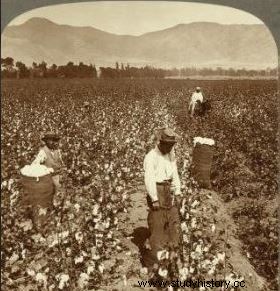Between 1849 and 1874, tens of thousands of workers who came from China to work in Peru were abusively exploited.

One of sixteen 19th century Chinese immigrant burials century recently discovered at a pre-Inca site in Lima, Peru.
ARCHAEOLOGY. But what were Chinese burials doing in a pre-Inca pyramid on the outskirts of Lima, Peru? It is with surprise that Peruvian archaeologists unearthed at the top of the Huaca Bellavista , an ancient adobe pyramid about 800 years old built by the Ychsma (1), a pre-Columbian people, the remains of 16 Chinese workers who died in Peru at the end of the 19 th century and at the very beginning of the XX th century. On August 23, 2017, the Ministry of Culture of Peru and Roxana Gomez, the archaeologist in charge of these excavations, announced the discovery of 11 bodies buried directly in the ground, simply wrapped in humble canvases of fabric while five others lay in wooden coffins. Some deceased still wore the braid. A beer contained an opium pipe.

An opium pipe near the remains of a 19th century Chinese immigrant century. His coffin was unearthed at the Huaca Bellavista site in Lima, Peru. © Ministerio de Cultura
A land of immigration for Chinese workers
To understand this unusual presence of Asian nationals in the gray earth sediments of a pre-Inca building, it is necessary to know that Peru was one of the major destinations for Chinese workers in Latin America in the 19 th sup> century, after slavery was abolished there in 1854 (the slave trade had begun to decline sharply after the declaration of independence of Peru in 1821, the country having then freed itself from Spanish colonial domination). In an article published in the Journal of the Society of Americanists dated 1994 (2), Isabelle Lausent-Herrera, anthropologist in charge of research at CNRS-Credal, had already returned to the presence of these Chinese workers in Peru. The researcher then explained that between 1849 and 1874, the economic reconstruction of the country requiring a large workforce that neither the freed Africans nor the Indians could provide, nearly 100,000 Chinese from the provinces of Fujian and Guangdong , came to replace them in the haciendas , the vast agricultural holdings. “The large landowners, the hacendados, and the concessionaires of the guano island farms turned to China, where there already existed a form of trafficking in contract workers, that of the coolies, very similar to that of the Africans” , declared Isabelle Lausent-Herrera joined by Sciences et Avenir . “Chinese migrants were leaving a crumbling empire. The Opium Wars [1839-1860] (3) having forced China to open up, the loss of its major trading ports and major agrarian revolts with millions of deaths, engendered a chaos conducive to these departures adds the specialist.
Arrived in Peru in 1849 in the most total destitution, the hope of a better life quickly vanished. In 1994, Isabelle Lausent-Herrera wrote:“Enslaved by abusive contracts [from 4 to 8 years old] connecting them for the most part to guano exploitations or to the large sugar and cotton estates of the Peruvian coast, these Chinese were projected into a totally foreign and hostile space . The disarray in which they were plunged, and which resulted in very many suicides, was increased by the deprivation of companions. Brought in without a wife, subjected to perpetual attacks by black or mixed-race foremen, grouped together in barracks in the greatest promiscuity, the Chinese sent back from their arrival the image of a degraded race dominated by its vices. /em>

Chinese workers in Peru at the end of the 19 th century. The Chinese of Fujian Province belonged to the Hokkien, Minnan and especially Hakka dialect groups. Subsequently, the recruitment of this Asian workforce took place mainly in the regions of Hong Kong and Macao. © Ministerio de Cultura
Cemetery prohibited
In the 19 th century, Chinese coolies were not allowed to be buried in the Christian cemeteries of Lima. So there were improvised burials such as those discovered at the Huaca Bellavista . “Most of the large land estates around Lima having developed around ancient pre-Columbian sites including these ancient sacred spaces or huacas, these unconsecrated places were used to bury the unbaptized such as these mostly Buddhist or Confucian Chinese workers ”, adds Isabelle Lausent-Herrera. A discovery which is however not the first in the Andean country. In the past, remains of these marginalized populations have been accidentally found in other huacas and prehispanic cemeteries. This was the case in Tarma and Casma, on the northern coast of Peru. At the very end of the 19 th century, however, these workers from the Far East seem to have begun to receive better treatment. “In urban areas, many of the Chinese had been baptized at the time of their death, as a result of which they were then buried in the new public cemeteries” , specifies Isabelle Lausent-Herrera, author of a study on the Chinese tombstones of the cemetery of Presbiterio Matias Maestro, in the inner suburbs of Lima.
Over time, a small Chinese community was able to settle in the Peruvian capital. However, Chinese immigration was severely restricted in 1909 and totally prohibited from 1930. With Cuba in 1848 (for the large sugar plantations), and the United States in 1847 (for the construction of the railways ), Peru is now the country with the oldest Chinese community in America.
(1) The Ychsma (Ychma or Ichma) were one of the first major cultures to appear in the Lima region after the dissolution of the Wari (or Huari) Empire (750-1000). Their integration into the Inca Empire took place in the 15th century, just before the arrival of the Spanish Conquistadors.
(2) The Chinese of Peru:a reconstructed identity , by Isabelle Lausent-Herrera, Journal of the Society of Americanists, year 1994, volume 80, Number 1, pp.169-183.
(3) The New Chinese Immigration to Peru , by Isabelle Lausent-Herrera, European Journal of International Migration, vol. 25 n°1, 2009, p. 71-96.
